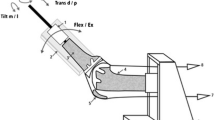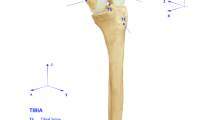Abstract
Purpose
Different bearing designs in unicondylar knee arthroplasty (UKA) have been developed in order to influence the rate of polyethylene wear. Increased anteroposterior translation and rotation after UKA has been hypothesized due to changes in joint surface geometry. The mobile bearing design was expected to show increased anteroposterior translation compared to the fixed bearing and biconcave bearing design.
Methods
Six human cadaver knees were used for the tests. Anteroposterior and rotational knee stability was analysed in 0°, 30°, 60°, 90° and 120° of knee flexion using a robotic testing system (KR 125, KUKA Robots Augsburg, Germany). Three forces and moments were measured in a Cartesian coordinate system with a resolution of 1.0 N and 0.1 Nm.
Results
There was no difference between the native knees and the knees after UKA in AP translation and rotation in all knee flexion angles. The factor knee flexion angle had a significant impact on the anterior translation when the type of bearing was neglected (p ≤ 0.015).
Conclusion
This study shows that the natural knee stability in AP translation and rotation can be preserved in UKA. The preserved knee stability in different planes after UKA underlines the advantage of UKA when surgery is required in osteoarthritic changes of the medial compartment.






Similar content being viewed by others
References
Allen CR, Wong EK, Livesay GA, Sakane M, Fu FH, Woo SL (2000) Importance of the medial meniscus in the anterior cruciate ligament-deficient knee. J Orthop Res 18:109–115
Argenson JN, Komistek RD, Aubaniac JM, Dennis DA, Northcut EJ, Anderson DT, Agostini S (2002) In vivo determination of knee kinematics for subjects implanted with a unicompartmental arthroplasty. J Arthroplast 17:1049–1054
Bartley RE, Stulberg SD, Robb WJ, Sweeney HJ (1994) Polyethylene wear in unicompartmental knee arthroplasty. Clin Orthop Relat Res 299:18–24
Campbell DG, Johnson LJ, West SC (2006) Multiparameter quantitative computer-assisted tomography assessment of unicompartmental knee arthroplasties. ANZ J Surg 76:782–787
Casino D, Martelli S, Zaffagnini S, Lopomo N, Iacono F, Bignozzi S, Visani A, Marcacci M (2009) Knee stability before and after total and unicondylar knee replacement: in vivo kinematic evaluation utilizing navigation. J Orthop Res 27:202–207
Collier MB, Engh CA, McAuley JP, Engh GA (2007) Factors associated with the loss of thickness of polyethylene tibial bearings after knee arthroplasty. J Bone Joint Surg Am 89:1306–1314
Freeman MA, Pinskerova V (2005) The movement of the normal tibio-femoral joint. J Biomech 38:197–208
Goodfellow JW, O’Connor J (1986) Clinical results of the Oxford knee. Surface arthroplasty of the tibiofemoral joint with a meniscal bearing prosthesis. Clin Orthop Relat Res 205:21–42
Griffin T, Rowden N, Morgan D, Atkinson R, Woodruff P, Maddern G (2007) Unicompartmental knee arthroplasty for the treatment of unicompartmental osteoarthritis: a systematic study. ANZ J Surg 77:214–221
Harner CD, Mauro CS, Lesniak BP, Romanowski JR (2009) Biomechanical consequences of a tear of the posterior root of the medial meniscus. Surgical technique. J Bone Joint Surg Am 91(Suppl 2):257–270
Heinert G, Kendoff D, Preiss S, Gehrke T, Sussmann P (2011) Patellofemoral kinematics in mobile-bearing and fixed-bearing posterior stabilised total knee replacements: a cadaveric study. Knee Surg Sports Traumatol Arthrosc 19:967–972
Hopper GP, Leach WJ (2008) Participation in sporting activities following knee replacement: total versus unicompartmental. Knee Surg Sports Traumatol Arthrosc 16:973–979
Iwaki H, Pinskerova V, Freeman MA (2000) Tibiofemoral movement 1: the shapes and relative movements of the femur and tibia in the unloaded cadaver knee. J Bone Joint Surg Br 82:1189–1195
Kaya Bicer E, Servien E, Lustig S, Demey G, Ait Si Selmi T, Neyret P (2010) Sagittal flexion angle of the femoral component in unicompartmental knee arthroplasty: is it same for both medial and lateral UKAs? Knee Surg Sports Traumatol Arthrosc 18:928–933
Kort NP, van Raay JJ, Cheung J, Jolink C, Deutman R (2007) Analysis of Oxford medial unicompartmental knee replacement using the minimally invasive technique in patients aged 60 and above: an independent prospective series. Knee Surg Sports Traumatol Arthrosc 15:1331–1334
Kretzer JP, Jakubowitz E, Reinders J, Lietz E, Moradi B, Hofmann K, Sonntag R (2011) Wear analysis of unicondylar mobile bearing and fixed bearing knee systems: a knee simulator study. Acta Biomater 7:710–715
Levy IM, Torzilli PA, Gould JD, Warren RF (1989) The effect of lateral meniscectomy on motion of the knee. J Bone Joint Surg Am 71:401–406
Levy IM, Torzilli PA, Warren RF (1982) The effect of medial meniscectomy on anterior-posterior motion of the knee. J Bone Joint Surg Am 64:883–888
Li G (2005) In vivo articular cartilage contact kinematics of the knee: an investigation using dual-orthogonal fluoroscopy and magnetic resonance image-based computer models. Am J Sports Med 33:102–107
Lyons MC, MacDonald SJ, Somerville LE, Naudie DD, McCalden RW (2012) Unicompartmental versus total knee arthroplasty database analysis: is there a winner? Clin Orthop Relat Res 470:84–90
Machner A, Pap G, Awiszus F (2002) Evaluation of quadriceps strength and voluntary activation after unicompartmental arthroplasty for medial osteoarthritis of the knee. J Orthop Res 20:108–111
Paletta GA, Manning T, Snell E, Parker R, Bergfeld J (1997) The effect of allograft meniscal replacement on intraarticular contact area and pressures in the human knee. A biomechanical study. Am J Sports Med 25:692–698
Pandit H, Jenkins C, Beard DJ, Price AJ, Gill HS, Dodd CA, Murray DW (2010) Mobile bearing dislocation in lateral unicompartmental knee replacement. Knee 17:392–397
Papageorgiou CD, Gil JE, Kanamori A, Fenwick JA, Woo SL, Fu FH (2001) The biomechanical interdependence between the anterior cruciate ligament replacement graft and the medial meniscus. Am J Sports Med 29:226–231
Price AJ, Rees JL, Beard DJ, Gill RHS, Dodd CAF, Murray DM (2004) Sagittal plane kinematics of a mobile-bearing unicompartmental knee arthroplasty at 10 years: a comparative in vivo fluoroscopic analysis1. J Arthroplasty 19:590–597
Robinson BJ, Rees JL, Price AJ, Beard DJ, Murray DW, McLardy Smith P, Dodd CA (2002) Dislocation of the bearing of the Oxford lateral unicompartmental arthroplasty. A radiological assessment. J Bone Joint Surg Br 84:653–657
Schulze M, Hartensuer R, Gehweiler D, Hölscher U, Raschke MJ, Vordemvenne T (2012) Evaluation of a robot-assisted testing system for multisegmental spine specimens. J Biomech. doi: 10.1016/j.jbiomech.2012.02.013
Suggs JF, Li G, Park SE, Sultan PG, Rubash HE, Freiberg AA (2006) Knee biomechanics after UKA and its relation to the ACL—a robotic investigation. J Orthop Res 24:588–594
Victor J, Labey L, Wong P, Innocenti B, Bellemans J (2010) The influence of muscle load on tibiofemoral knee kinematics. J Orthop Res 28:419–428
Weston-Simons JS, Pandit H, Gill HS, Jackson WF, Price AJ, Dodd CA, Murray DW (2011) The management of mobile bearing dislocation in the Oxford lateral unicompartmental knee replacement. Knee Surg Sports Traumatol Arthrosc 19:2023–2026
Whittaker JP, Naudie DD, McAuley JP, McCalden RW, MacDonald SJ, Bourne RB (2010) Does bearing design influence midterm survivorship of unicompartmental arthroplasty? Clin Orthop Relat Res 468:73–81
Acknowledgments
We thank the Robert Mathys Foundation for their financial support and Joshua Schkrohowski, MD, for his helpful comments regarding the manuscript.
Author information
Authors and Affiliations
Corresponding author
Rights and permissions
About this article
Cite this article
Becker, R., Mauer, C., Stärke, C. et al. Anteroposterior and rotational stability in fixed and mobile bearing unicondylar knee arthroplasty: a cadaveric study using the robotic force sensor system. Knee Surg Sports Traumatol Arthrosc 21, 2427–2432 (2013). https://doi.org/10.1007/s00167-012-2157-5
Received:
Accepted:
Published:
Issue Date:
DOI: https://doi.org/10.1007/s00167-012-2157-5




